
 |
|
|
|
|
Roman Republic (to 27 BC) Coins
The images are
thumbnails. Click to see larger version. For information on the
person, click name.
Mounted page links go to PDF file about the coin.
| Anonymous (211 BC) |
gold 60 asses, 3.4g, S 3, RF R-7,
211-208 B.C., Rome mint
Obv. Helmeted head of bearded Mars r,
mark of value ↓X (60) below |
|
| Anonymous (207 BC) |
denarius, 4.14g, S 39, RF R-26, 207 B.C.,
Rome mint
Obv. Helmeted head of Roma right,
mark of value
"X" behind |
|
| Q. Marcius Libo (148 BC) |
denarius, 3.9g, S 90, RF R-1,
148 B.C., Rome mint
Obv. LIBO, Head of Roma right,
mark of value X below chin, LIBO
behind |
|
| C. Servilius (136 BC) |
denarius, 4.05g, S 116, RF R-21,
136 B.C., Rome mint Obv. Head of Roma right
wearing winged helmet surmounted by eagle's beak; wreath The earliest use of "ROMA" on obverse rather than reverse |
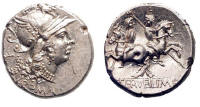 |
| C. Malleolus C.f. (118 BC) |
denarius serratus, 3.94g, S 158, RF
R-27, 121 B.C., Narbo mint Obv. Helmeted head of
Roma wearing Attic helmet right, mark of value "X" behind, encircled by moneyer's name C. MALLE
CF The earleist use of denarious serratus. This issue, distinguished by flans with serrated edges, was first minted at the newly founded city of Narbo, the first Roman colony in Gaul. The two principal magistrates (Licinius Crassus and Domitius Ahenobarbus) produced their coins in association with five junior colleagues. |
 |
| M. Cipius M.F. (115 BC) |
denarius, 4.0g, S 166, RF R-25,
115/114 B.C., Rome mint Obv. Helmeted head of
Roma right, mark of value "X" behind, M CIPI MF before |
 |
| L. Scipio Asiagenus (106 BC) |
denarius serratus, 4.01g, S 188, RF R-20,
106 B.C., Rome mint Obv. Laureate head of
Jupiter left The reason for the introduction of denarii with notched edges at the Rome mint at this time is unknown (they had first been struck in Gaul 12 years earlier, see example above) |
 |
| Q. Minucius Thermus (103 BC) |
denarius, 3.84g, S 197, RF R-12,
103 B.C., Rome mint Obv. Mars with crested helmet
facing left |
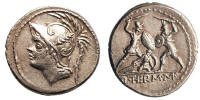 |
| L. Calpurnius Piso Frugi (90 BC) |
denarius, 4.15g, S 235, RF R-23, 90 B.C.,
Rome mint Obv.
Laureated head of Apollo right, vine leaf behind One of the principal war coinages minted in Rome during the conflict with the Marsic Confederation. |
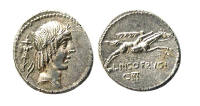 |
| C. Vibius C.f. Pansa (89 BC) |
denarius, 3.81g, S 242, RF R-29,
89 B.C.,
Rome mint Obv.
Laureated head of Apollo right, PANSA behind |
 |
| L. Titurius L.f. Sabinus (89 BC) |
denarius, 4.06g, S 249, RF R-30,
89 B.C.,
Rome mint Obv.
Bare head of bearded King Tatius, SABIN behind, TA in monogram before ex Dr. Fontana |
 |
| C. Mamilius Limetanus (82 BC) |
denarius serratus, 3.81g, S 282, RF R-24,
82 B.C., Rome mint Obv. Draped bust of Mercury right,
wearing winged petasus, caduceus over shoulder control letter "E" behind The obverse and reverse of this coin refer to the lineage of the gens Mamilia, who claimed their descent from Mamilia, the daughter of Telegonus, the son of Ulysses and Circe, and a descendant of Mercury. The reverse scene depicts the moment when, returning home from the Trojan Wars in the guise of a beggar so as to surprise and kill the many suitors of his wife Penelope, Ulysses' aged dog Argos recognizes him |
 |
| C. Naevius Balbus (79 BC) |
denarius serratus, 3.84g, S 309, RF R-11, 79 B.C.,
Rome mint Obv.
Diademed head of Venus right wearing earing and pearl necklace, S C (Sentus
Consulto) behind This represents coinage from a large output specially authorized by decree of the Senate necessitated by the extensive military operations during the dictatorship of Sulla. The three-horse chariot (triga) is rarely depicted on Republican coinage (1 other). |
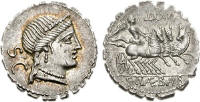 |
| P. Satrienus (77 BC) |
denarius, 3.9g, S 319 , RF R-4, 76-75 B.C.,
Rome mint
Obv. Helmeted head of Roma right with control
mark XI behind |
|
| Cn. Lentulus (76 BC) |
denarius, 3.93g, S 323, RF R-9, 77 B.C.,
Spain mint Obv. Bust of the Genius of the
Roman People right, G.P.R. above, scepter over right shoulder Lentulus strikes in Spain in his capacity as quaestor to the proconsul Pompey, who had been sent to the peninsula to assist in a protracted war ex Jacob Stein, Gemini V auction |
 |
L. Farsuleius Mensor |
denarius, 3.88g, S 328 (this coin), RF R-22,
75 B.C., Rome mint
Obv. Diademed and draped bust of Libertas,
SC below chin, MENSOR before, cap and control IIIXX↑
behind the Sear plate coin |
|
Q. Fufius Calenebus and P. Mucius Scaevola (Cordus) |
denarius serratus, 4.16g, S 338 , RF R-17,
70 B.C., Rome mint
Obv. Conjoined heads of Honos and Virtus,
former laureated, later helmeted, HO behind, VIRT (RT in monogram)
before, KALENI below ex A. Lynn |
|
| L. Vettius Sabinus (69 BC) |
denarius serratus, 3.79g, S 339 , RF R-19,
69 B.C., Rome mint
Obv. Bare head of beared king Tatius TA in
monogram below chin, SABIVS behind, SC before |
|
| Q. Pomponius Musa (66 BC) |
denarius, 4.08g, S 351 , RF R-13,
66 B.C., Rome mint
Obv. Q. POMONI MVSA, diademed head of Apollo right |
|
| L. Roscius Fabatus (64 BC) |
denarius serratus, 3.9g, S 363 , RF R-6,
64 B.C., Rome mint
Obv. [L. Rosci] Head of Juno Sospita right,
shield |
|
| L. Cassius Longinus (60 BC) |
denarius, 3.90g, S 364, RF R-10, 60 B.C.,
Rome mint Obv.
Veiled and draped bust of Vesta left, C before, kylix behind Sear: The control letters on obverse spell out the moneyer's praenomen and nomen, L CASSI (one S reversed) ex Jacob Stein, Gemini V auction |
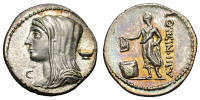 |
|
M. Aemilius Scaurus (58 BC) |
denarius, 3.8g, S 378, RF R-2, 58 B.C.,
Rome mint
Obv. King Aretas kneeling beside camel holding
olive branch, M SCARV above, (refers to the defeat of the Nabathean
Arabs), EX SC in field Struck to commemorate the defeat of Aretas III by Pompey's general Marcus Scaurus. An early instance of moneyer commemorating an event connected with his own history. M. Aemilius, Governor of Syria, stopped the incursion of the Nabathean Arabians and forced Aretas to submit and pay a fine of 300 talents to Pompey. |
|
| A. Plautius (55 BC) |
denarius, 4.2g, S 395, RF R-3, 55 B.C.,
Rome mint
Obv. A PLAVTIVS before, AED CVR SC behind ,
turreted hd of Cybele right Sear: "Aulus Plautius strike as curule aedile. The problematic interpretation of the reverse type appears to have been most successfully resolved by Harlan in RRM (pp 116-118) who identified the kneeling figure as Aristobulus, the Jewish high priest, then held captive by Pompey in Rome" |
|
| Q. Caepio Brutus
(54 BC) |
denarius, 3.73g, S 397, RF R-8, 54 B.C.,
Rome mint
Obv. head of Liberty right, LIBERTAS behind Sear: The most famous of Caesar's assassins in 44 BC M. Junius Brutus had lost his father while a young boy and was adopted by his uncle Q. Servilius Caepio, thus changing his name to Q. Caepio Brutus. Coin type refers to his illustrious ancestry and his patriotic devotion to the freedom of the Republic. ex Jacob Stein, Gemini V auction |
 |
| Koson |
gold stater, 8.42g, RPC 701, RF P-1, ca. 50 B.C. SKYTHIA, Geto-Dacians. Koson. |
|
|
L. Cornelius Lentulus & C. Claudius Marcellus (49 BC) |
denarius, 3.9g, S 415, RF R-18,
49 B.C.
Obv. Head of Apollo right,
close-fitting band obscured by fullness of hair, L• LENT• C• MARC (NT
and MA ligatured) before, COS behind The exiled consuls for 49 BC here strike in support of Pompey |
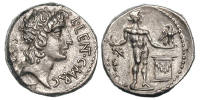 |
|
L. Plautius Plancus (47 BC) |
denarius, 3.8g, S 429, RF R-16,
47 B.C.
Obv. Head
of Medusa facing with dishevelled hair, below, L·PLAVTIVS |
 |
| L. Mussidius Longus (42 BC) |
denarius, 3.9g, S 494, RF R-5,
42 B.C., ex A. Lynn
Obv. CONCORDIA. Veiled head of Concordia
right Cloacina was worshipped by the Romans as the goddess of the Cloaca Maxima (the main sewage drain) and of the entire sewer system. The remains of the shrine are still visible. Pliny reports that when the Romans and the Sabines decided to make peace, both laid down their weapons at the location of the shrine and purified themselves. |
|
|
M. Brutus (85-42 BC) |
denarius struck by Lentulus Spinter, mint
at Smyrna, 3.8g, S 1431, RF R-14,
42 B.C.
Obv. Axe, simpulum and sacrificial knife,
BRVTVS below |
 |
|
C. Cassius (59-44 BC) |
denarius struck by Lentulus Spinter, mint
at Smyrna, 4.24g, S 1446, RF R-15,
42 B.C.
Obv. Tripod surmounted by cauldron, fillet
hanging on either side, C CASSI on left, IMP on right |
 |
|
Julius Caesar (59-44 BC) |
denarius, 3.8g, S 49, RF B-1,
49/48 B.C.
Obv. Elephant r trampling serpent, CAESAR
below |
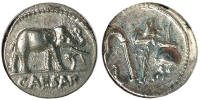 |
| Mark Antony and Octavian | denarius, mint at
Ephesus, 3.90g, S 1504, RF R-31,
spring/summer 41 BC
Obv. M ANT IMP AVG III VIR RPC M
BARBAT Q P (MP and AV in mongram), bare head of Mark Antony right |
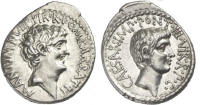 |
|
Mark Antony (43-31 BC) |
denarius, Patrae mint?, 3.6g, S
27, RF H-1,
ex Millennia, 32/31 B.C.
Obv. ANTAVG III VIR RPC War galley r., tyros
behind prow Seaby: "struck by Antony for the use of his fleet and legions when he was preparing for the struggle with Octavian. ... of baser metal than ordinary currency." |
 |
|
Mark Antony (43-31 BC) |
denarius, Patrae mint?, 3.3g, S
27, RF H-2, 32/31 B.C.
Obv. ANTAVG III VIR RPC War galley r., tyros
behind prow Seaby: "struck by Antony for the use of his fleet and legions when he was preparing for the struggle with Octavian. ... of baser metal than ordinary currency." |
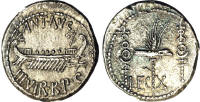 |
Richard Frajola (June 2010)